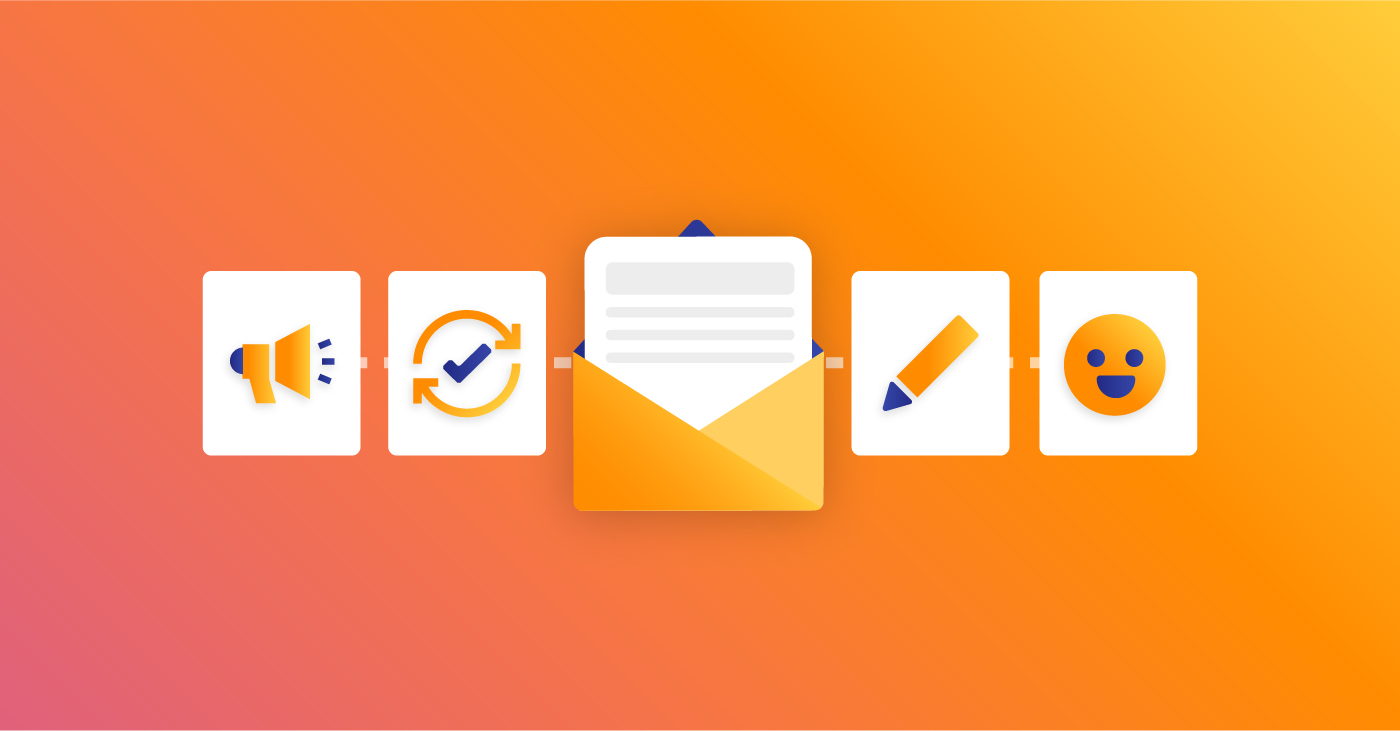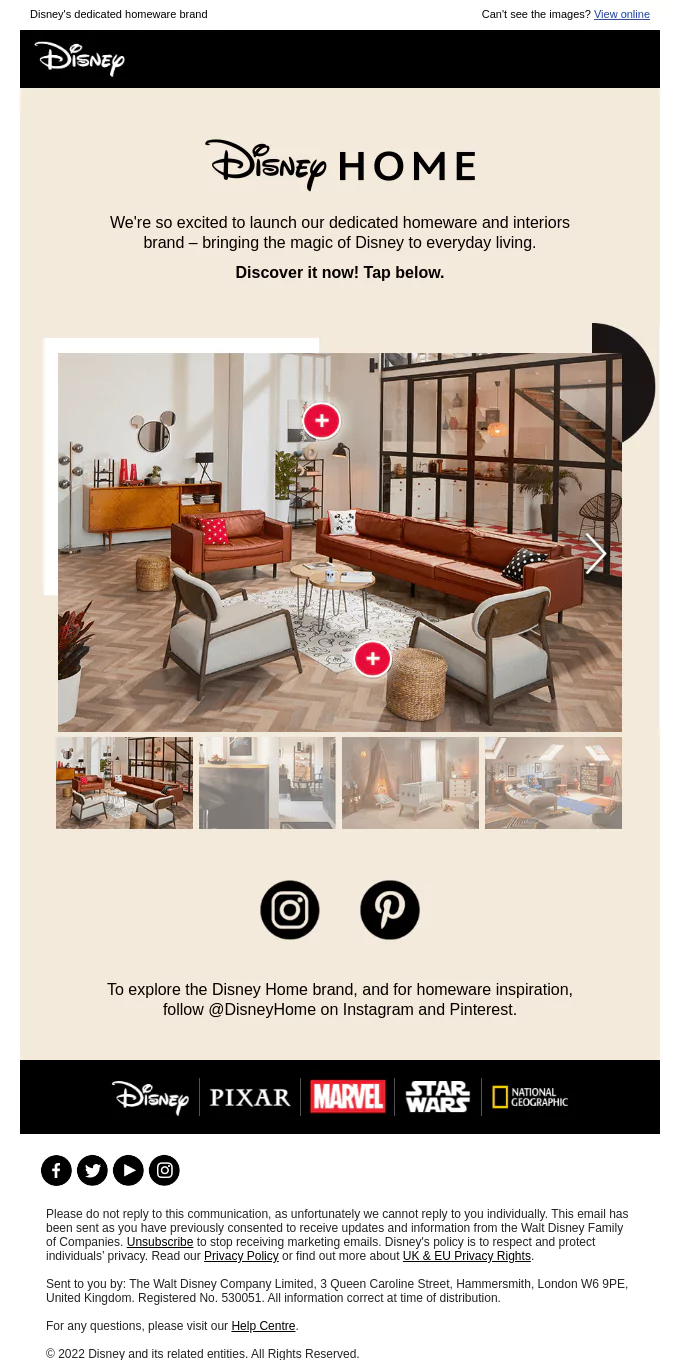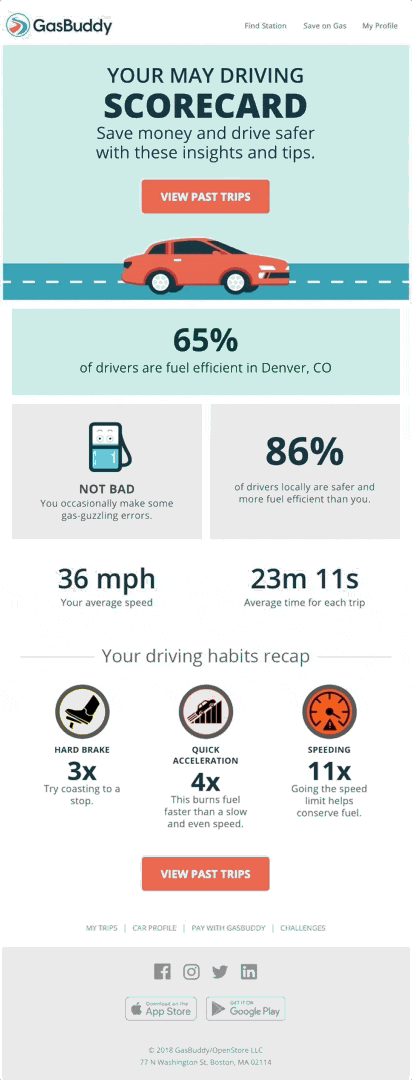The 6 Biggest Email Design Trends Of 2022 So Far–And What We Can Learn From Them
October 4, 2022 8 min read

In the last ten years, email design has evolved from plain-text messages to fully-fledged HTML newsletters, including images, videos, and animation. As email design continues to develop, so do the trends that dictate those changes – while some email design trends come and go quickly, others have a lasting impact.
In this article, we’ll provide an in-depth explanation of email design and look at some of the most popular email design trends we’re seeing this year.
What is Email Design?
Email design is the practice of strategically planning and creating an email to resonate with an audience. Marketers use it to optimize the look and feel of their email campaigns, grab recipients’ attention, and evoke action.
Email design considers every element of an email’s content – from its subject line and preview text to images, buttons, and text – to make the final message as cohesive and attractive as possible.
Why Prioritize Email Design?
You may be thinking: “Why go through all that trouble for a simple email? Does it make a difference?” The answer is yes; it does, and here’s why:
Emails are designed to be fast, in-and-out messages – the average person spends only 13.4 seconds reading them. No one has the interest or patience to stop and consider every email – it’s up to the design elements and planning to catch their attention.
By carefully strategizing the layout, style, and overall look of an email message, marketers can increase their chances of catching recipients’ eye and entice them to open the email and take action.
How to Design an Excellent Email
Negating the importance of design means setting your emails up for failure from the get-go. It’s essential to follow a due process when creating them and include the elements and features that are most likely to make them a success. Here are some tips to keep in mind when designing an effective email marketing campaign.
1. Create an Easy-to-Understand Structure
Hard-to-understand, poorly written, and unprofessional-looking emails rarely get read – if not sent straight to the junk folder.
It’s essential to have a clear email structure that’s easy for recipients to follow, which means using short paragraphs, bullet points, and clear headings. The layout should also be visually appealing and easy on the eyes, with plenty of white space and contextually relevant images.
2. Write a Compelling Subject Line and Preview Text
With so many emails filling up people’s inboxes daily, making sure that yours stand out is more important than ever.
The subject line and preview text are what recipients see first, so make them count. Write something attention-grabbing and relevant to the email’s content.
3. Use a Responsive Design
Today’s consumers are everywhere and receive emails in different ways. Some have standard desktop computers, while others use smartphones, tablets, and different email clients such as Mozilla Thunderbird or Outlook.
Design your email using a responsive layout that can adapt to different screen sizes and still look great. This way, no matter how recipients view your message, they’ll have a positive experience.
4. Maintain Brand Consistency
Like any other facet of marketing, branding is key to crafting an effective campaign. A common mistake businesses make is a lack of consistency between emails which notably differ in formatting, color, messaging, and tone. Inconsistency can not only confuse recipients but also comes off as unprofessional.
When creating an email campaign, consider how it will reflect on your brand as a whole. Keep things like spacing, font, and color palettes comparable – if not the same – and use messaging that is on-brand and in line with your company’s voice.
5. Include a Mixture of Engaging Formats
As email messages are often brief, recipients don’t spend much time on them unless something interests them. A great way to get them to stick around is by using a variety of media types and formats. Images, text, animations – and yes, even video – all work exceptionally well to create engagement among recipients.
Of course, this is only true to an extent; always refrain from overloading your emails with unnecessary or obstructive elements.
6. Include a Clear CTA
Your marketing email should be nothing if not clear and actionable. Make a point to close every message with a concise and impactful CTA that will provoke recipients to take the next step – clicking through to your website, making a purchase, or signing up for a program.
6 Exciting Email Design Trends for 2022
As we’ve mentioned, email design is constantly changing and evolving. What was popular a few years ago may not be today, and what’s in style now may be completely different a few years later.
That’s why staying on top of the latest design trends is crucial to ensure that your email campaigns are always fresh, modern, and engaging.
Here are six exciting design trends to include in your email marketing strategy this year:
1. Clean, Simple Layouts
Enough with the fluff! This trend embodies the principle of concise and clear emails being the most effective. Clean layouts prioritize essential information, organize it well, and make it easy for recipients to understand message content even when quickly scanning it.
Here’s how you can apply clean and straightforward layouts into your campaigns:
- Less is more. When crafting a clean and straightforward layout, less is more. Prioritize the critical information and only include what is necessary.
- Use visual cues. Use things like whitespace, line breaks, and font size changes to draw attention to specific pieces of information and make them easier to scan.
- Be strategic with images. Images are a great way to add visual interest to your email, but be strategic about how and where you use them. Stick to one or two images per message and ensure they complement the email content rather than distract from it.
2. Interactive and Immersive Experiences
Email has been around for a couple of decades, and it’s no longer enough for marketers to write a message and expect consumers to bite. Luckily, newer aspects of HTML5 have made it possible for designers to create email campaigns that are more interactive and immersive, giving recipients a unique experience.
This email by Disney Home is an excellent example of interactivity, featuring several expandable points throughout an image of a living room.

Source: Ready Good Emails
Some ways you can integrate this into your strategy include:
- Variation toggles
- Mini-games
- Quizzes
- Polls
3. Mixed Media
Like interactive messages, mixed media is an excellent way to stand out from the confines of a conventional email and give recipients a more engaging experience. You can create an attention-grabbing email by incorporating GIFs, various images, videos, and other media types. Again, remember not to overdo it – the goal here should be to add enough elements for users to notice but not so many that they feel overwhelmed and inclined to close the message.
4. Retro Design Elements
No matter what year it is, people love reminiscing on past styles through retro design elements. You can achieve this trend in a few different ways – either by using vintage fonts, colors, and images or by taking a more modern approach and incorporating subtle throwbacks.
Here’s a fantastic example of a vintage-style email by Ennismore Hotels. With a simple structure and excellent font, it’s perfectly reminiscent of the early 20th century while remaining stylish and fun.
Here are some tips for creating your retro-inspired email designs:
- Nail down your target era. What point in time are you trying to emulate in your email? The funk of the 70s? Aesthetics of the 90s? Consider what would be most appropriate and visually appealing for your target audience.
- Use muted colors. For a more vintage look, stick to muted colors to give your email design an aged feel that’s still aesthetically pleasing.
- Incorporate a few key retro elements. You don’t need to go overboard with this trend. A few well-placed retro elements will do the trick.
Examples for popular decades include:
- Art-deco arches and waves for the 1920s
- Bold colors and geometric shapes for the 1980s
- Boxy, digital layouts for Y2K
5. Pastels and Gradients
Pastels and gradients are self-explanatory, but they’re also super popular right now. You can use these elements in several ways (backgrounds, buttons, etc.) to create an email design that’s on-trend and visually appealing.
Here’s how you can incorporate this trend into your email designs.
- Pastel colors as background images. Pastel backgrounds are a great way to add a pop of color without going overboard. Check out this email from Lyft – it features a good mix of brand colors while maintaining a simple and aesthetically pleasing look.
- Ombre gradients. Ombre is a gradient form that goes from light to dark (or vice versa). Ombre is a popular trend in email design, and you can use various colors to achieve it.
- Two-toned gradients. Similar to an ombre gradient, two-toned gradients use two colors instead of one – it’s a great way to add visual interest to an email without making it too busy.
6. Personalization
Emails are meant to be personal – after all, you send them to specific individuals on your list. So it only makes sense that personalization would be a popular trend now and for the future of email design.
There are a few different ways you can personalize your email content, but some of the most common methods include:
- Using the recipient’s name. This is probably the most common form of personalization. By addressing your reader by name, you immediately make the recipient feel like you crafted the email for them and didn’t just send out a mass blast.
- Geotargeting. You can use the recipient’s location to personalize the email content. Geotargeting could be as simple as including their city or state in the subject line or greeting, or you could get more specific and use their location to target content.
- Behavioral targeting. You can also use the recipient’s past behavior to personalize your email content. Behavioral targeting could be sending them a coupon for their favorite product or recommending similar items to their prior purchases.
This email by GasBuddy incorporates personalization into its design by including metrics unique to recipients’ driving habits.

Get Started With Email Design
While visual trends may come and go, the importance of a clear and well-designed email will always remain. By following the tips outlined in this article, you can create marketing emails that are visually appealing and highly effective in driving the marketing results you want.
Looking for more email inspiration? Check out these templates, planners, and other assets, or get started with Benchmark Email to take your email marketing game to the next level.
AUTHOR BIO:
Rin writes about all sorts of topics in the realm of marketing and loves being able to share knowledge with others.



